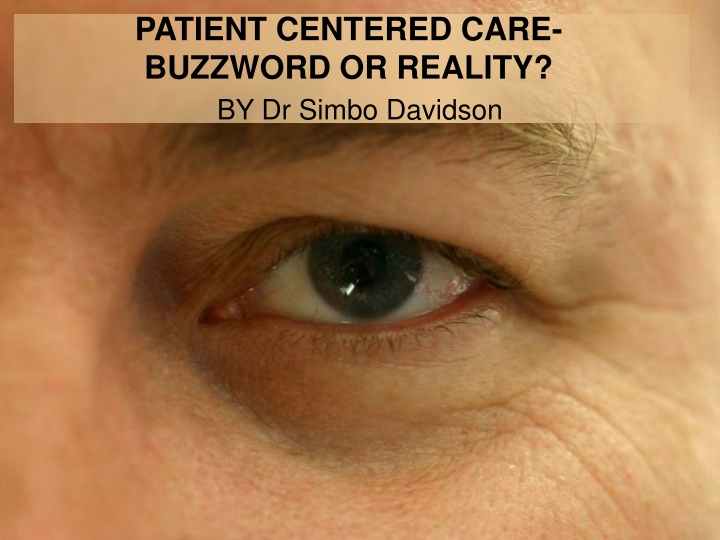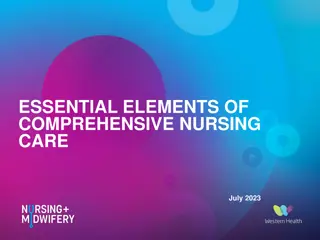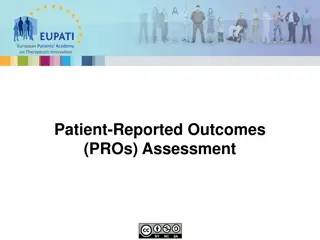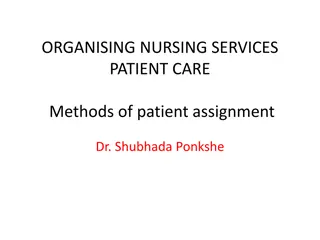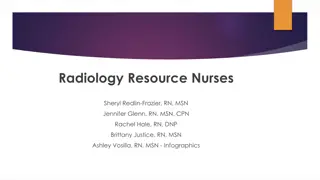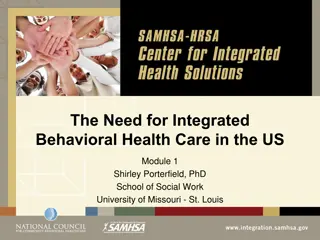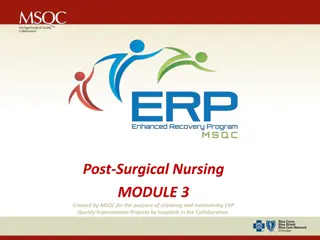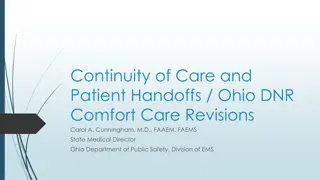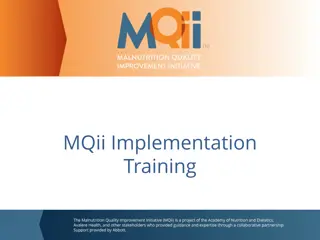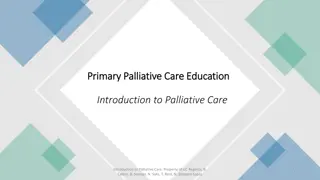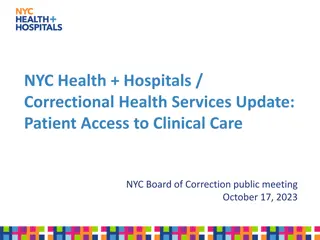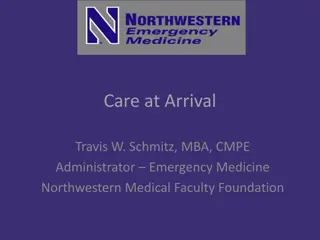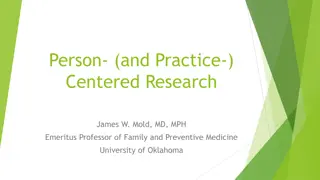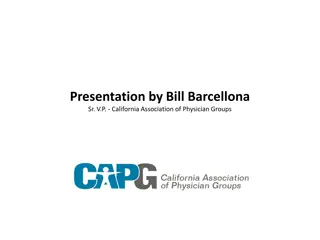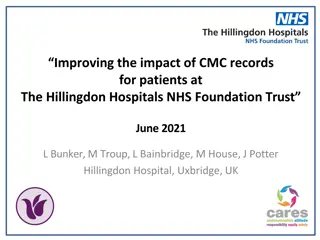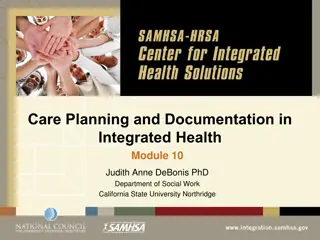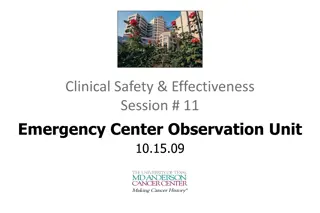Patient-Centered Care: Core Elements and Strategies
Patient-Centered Care is explored through core elements such as respect for patients, team collaboration, and removing barriers. Strategies to achieve patient-centered care are discussed, including improving quality, access to care, and affordability. Case studies and study questions provide practical insights for healthcare professionals aiming to enhance patient experiences and outcomes.
Download Presentation

Please find below an Image/Link to download the presentation.
The content on the website is provided AS IS for your information and personal use only. It may not be sold, licensed, or shared on other websites without obtaining consent from the author.If you encounter any issues during the download, it is possible that the publisher has removed the file from their server.
You are allowed to download the files provided on this website for personal or commercial use, subject to the condition that they are used lawfully. All files are the property of their respective owners.
The content on the website is provided AS IS for your information and personal use only. It may not be sold, licensed, or shared on other websites without obtaining consent from the author.
E N D
Presentation Transcript
PATIENT CENTERED CARE- BUZZWORD OR REALITY? BY Dr Simbo Davidson
WHAT IS PATIENT-CENTERED CARE? AND HOW MAY WE ACHIEVE IT? What participants will learn Core elements of patient centered care Facilitators and Barriers to patient centered care Organizational cultural competency assessments Doctor-Patient relationship models that impact patient experience World Health measures for responsiveness to patients Case examples with study questions
PROCEED WITH THE CASE STUDY- BARRIERS TO PATIENT CENTERED CARE (WORK IN PAIRS)- 20 mins STUDY QUESTIONS How could Walter s family physician have behaved differently to change his poor outcome? Are there interventions that could have helped Walter avoid his use of the ER? What could have been done to ensure that Walter s referral for diagnostics wasn t lost? How can care be shaped to help Walter help himself in achieving his health goals? What can be done to improve cultural sensitivity for Metis and First Nation s patients?
IMPROVE QUALITY, ACCESS TO CARE AND AFFORDABILITY (COST)
CORE ELEMENTS OF PATIENT CENTERED CARE Respect for patient s values, needs convenience, culture, and preferences Providing adequate information during visits, while on admission, on patients diagnosis, treatments and lifestyle requirements Team collaboration in providing services so that patients are not referred randomly and tossed to and fro between specialists Ensuring that patients understand information provided eg teachback systems Removing barriers such as language barriers, staffing shortages, out of stock etc
WATCH THIS VIDEO- FACILITATORS OF PATIENT CENTERED CARE IN GENERAL ,WHAT MADE Dr ISMAIL UNIQUE? WHAT WERE THE BEHAVIORS SPECIFICALLY IN THIS VIDEO THAT MADE HIM HIGHLY APPRECIATED BY HIS PATIENTS? WHAT MAJOR LESSON CAN WE LEARN ABOUT DR ISMAIL S PATIENT CENTERED CARE STRATEGY?
CULTURAL COMPETENCY- ARE YOU CULTURALLY COMPETENT?- CHECK YOUR SCORE RELIGIOUS DIVERSITY CHECKLIST CULTURAL COMPETENCY IMPROVES THE PATIENT S EXPERIENCE 1. ARE YOU CONSIDERATE OF OTHER PERSON S RELIGIOUS BELIEFS WHEN PROVIDING CARE? 2. IS THERE ANYTHING WRONG WITH THE USE OF LOCAL LANGUAGES IN HEALTH SETTINGS? 3. WOULD YOU EMPLOY SOMEONE WHO OBSERVES RELIGIOUS DRESSING ? 4. HAVE YOU EVER EXCLUDED PERSONS FROM OTHER ETHNIC GROUPS WHEN RECRUITING? 5. DO YOU PROVIDE PATIENT INFORMATION IN MANY LOCAL LANGUAGES?
PATIENT EXPERIENCE- HOW DO WE MEASURE THIS? WORLD HEALTH MEASURES OF PATIENT EXPERIENCE WORLD HEALTH MEASURES- RESPONSIVENESS RESPONSIVENESS IS MORE THAN PATIENT SATISFACTION RESPONSIVENESS MEASURES THE PATIENT S EXPERIENCE
RESPONSIVENESS MEASUREMENT Percentage of persons who could not get an appointment in any week or month Percentage of patients who could not collect medications due to affordability or availability Patients rating of explanations offered by physician about diagnosis or treatment Patient s rating of time spent with physician during consultation Patient s rating for ease at which he could ask the doctor questions about his/her care Rating of extent to which patient was involved in the clinic decision making process
TYPES OF DOCTOR: PATIENT RELATIONSHIPS that impact EXPERIENCE MEDICAL PATERNALISM- The doctor determines what is best for the patient and takes a one sided decision. No options are offered to the patient and Doctor does not entertain questions INFORMATIVE MODEL- The Doctor informs the patient about the benefits, risks, prognosis, alternatives to treatment and allows the patient to choose. No recommendations are given INTERPRETIVE MODEL- The Doctor helps the patient to examine his/her preferences, beliefs and values and to make a rational decision- Recommends but does not persuade DELIBERATIVE MODEL- The doctor presents call relevant information and persuades the patient to take the most rationale option
SCORE WALTERS EXPERIENCE IF YOU WERE WALTER .. How would you rate the wait times for consultations out of 10 How would you rate the physicians communication about diagnosis or treatment? Out of 10 How would you rate the time spent with the doctor out of 10 How would you rate ability to ask questions and receive answers? Out of 10 How would you rate your involvement in the clinic decision making process? RATING EXPERIENCE
EXAMPLE OF PROM QUESTIONS- Hip & knee replacements, Varicose veins, hernia repair Without any difficulty With a little difficulty With some difficulty With much difficulty Unable to do it Are you able to Dress yourself in the morning, including underwear? Stand up from an armless chair? Get in and out of bed without help? Lift a full glass of water to your mouth Walk to your nearest bus-stop on flat ground
WHAT DO WE NEED TO DO BETTER? Implement patient surveys to check patient experience in all aspects of care Ensure that employees are reporting high levels of job satisfaction Improve team work between departments Improve communication between Providers & Patients Establish cultural competency interventions Carry out a root cause analysis Implement a QUALITY IMPROVEMENT SYSTEM- LEAN MANAGEMENT/ CQI (continuous quality improvement) IMPLEMENT IMPROVEMENTS THAT CAN CHANGE PATIENT EXPERIENCE for the better
